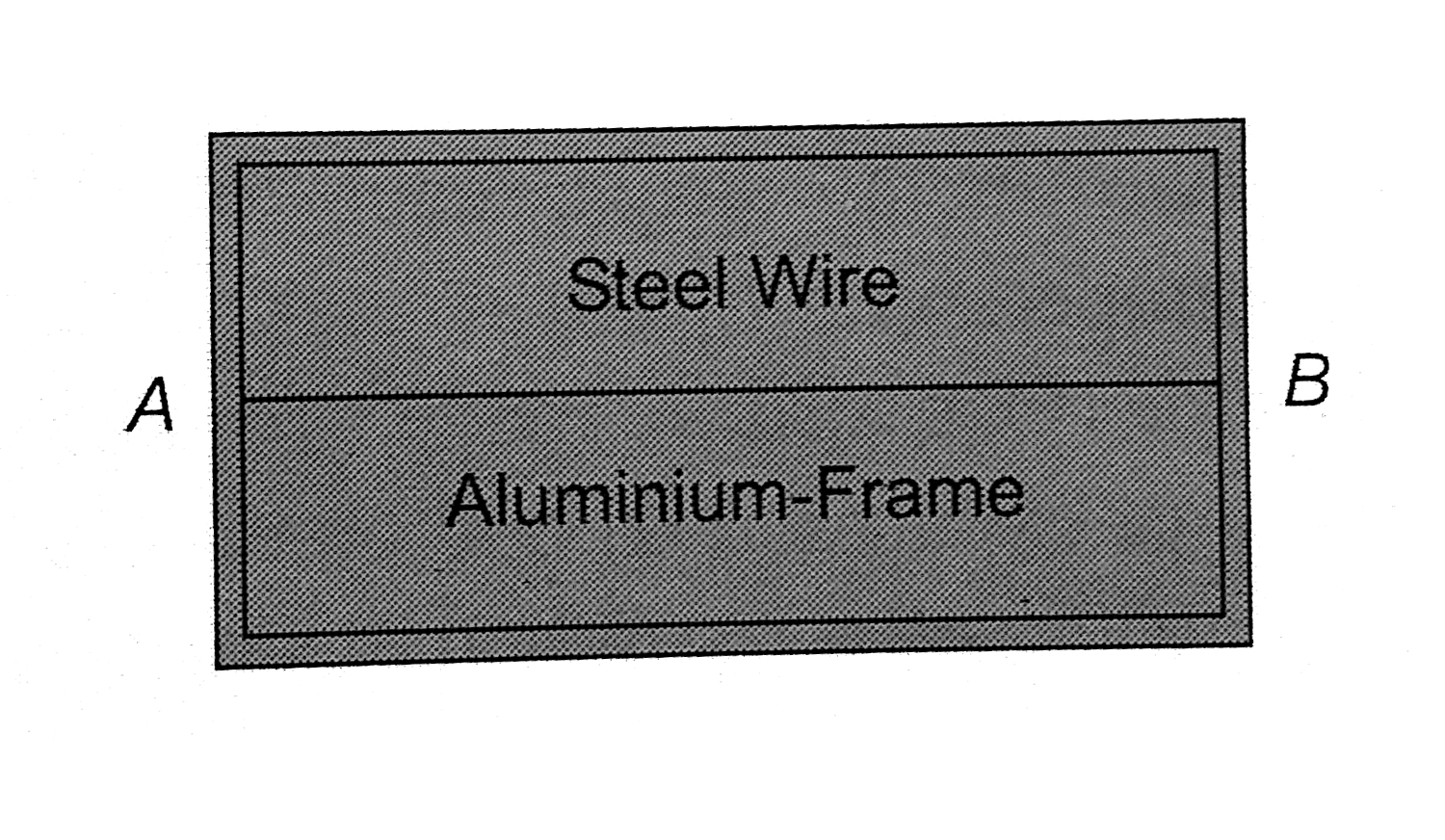A steel wire AB of length 100cm is fixed rigidly at points A and B in an aluminium frame as shown in the figure. If the temperature of the system increases through 100∘C, then the excess stress produced in the steel wire relative to the aluminium?
αAl=22×10−6/0C and αsteel=11×10−6/0C
young's Modulus of steel is 2×1011Nm−2.
_E01_116_Q01.png)
2.2×108Pa
22×108Pa
0.2×108Pa
220×108Pa
The correct Answer is:A
Net elongation Δl=(αAl−αSt)lΔt
Stress = Y(Strain)
Topper's Solved these Questions
- THERMAL PROPERTIES OF MATTERBOOK - NARAYNACHAPTER - THERMAL PROPERTIES OF MATTEREXERCISE - NCERT BASED QUESTIONS
25 Videos
- THERMAL PROPERTIES OF MATTERBOOK - NARAYNACHAPTER - THERMAL PROPERTIES OF MATTEREXERCISE - LEVEL-I(H.W.)
21 Videos
- THERMAL PROPERTIES OF MATTERBOOK - NARAYNACHAPTER - THERMAL PROPERTIES OF MATTEREXERCISE - LEVEL - II (C.W.)
20 Videos
- SYSTEM OF PARTICLES AND ROTATIONAL MOTION BOOK - NARAYNACHAPTER - SYSTEM OF PARTICLES AND ROTATIONAL MOTION EXERCISE - EXERCISE - IV
39 Videos
- THERMODYNAMICSBOOK - NARAYNACHAPTER - THERMODYNAMICSEXERCISE - Exercise
187 Videos
Similar Questions
A steel wire AB of length 85cm at 10∘C is fixed rigidly at points A and B in an aluminium frame as shown. If the temperature of the system is raised to 110∘C , what extra stress will be produced in the wire relative to aluminium frame. Assume that coefficient of linear expansion for aluminium and steel are 23×10−6/∘C and 11×10−6/∘C respectively and Young's moduls for steel is 2×1011 pa.

View SolutionWhat should be the length of steel and copper rods at 0∘C that the length of steel rod is 5 cm longer than copper at all termperature? Given αCu=1.7×105.∘C−1 and αsteel=1.1×105.∘C−1.
View Solution
Knowledge Check
A fine steel wire of length 4m is fixed rigidly in a heavy brass frame as ashown in figure . It is just taut at 20∘C. The tensile stress developed in steel wire it whole system is heated to 120∘C is :-
(Givenαbrass=1.8×10−5.∘C−1,αsteel=1.2×10−5.∘C,Ysteel=2×1011Nm−2,Ybrass=1.7×107Nm−2)
_S01_081_Q01.png) A1.02×104Nm−2B1.2×108Nm−2C1.2×106Nm−2D6×108Nm−2
A1.02×104Nm−2B1.2×108Nm−2C1.2×106Nm−2D6×108Nm−2A steel wire of length 20 cm and uniform cross-sectional area of 1mm2 is tied rigidly at both the ends at 45∘C. If the temperature of the wire is decreased to 20∘C, then the change in the tension of the wire will be
[Y for steel =2×1011Nm−2, the coefficient of linear expansion for steel =1.1×10−5/∘C−1]A22 NB32 NC55 ND60 N
Young 's modulus of steel is 2.0×1011Nm/(2). Express it is dynecm2.
View SolutionCompute the elongation of the steel wire in the figure. Unloaded length of the steel wire =1.5 m, the diameter of the wire is 0.25 m, Young's modulus of steel is 2×1011 N m−2.
View SolutionA steel rod is rigidly clamped at its two ends. The rod is under zero tension at 200C. If the temperature rises to 1000C, what force will the rod exert on one of the clapms? Area of cross section of the rod=2.00mm2 . Coefficient of linerar expansion of steel =12.0×10−6^0C−1 and Young's modulus of steel 2.00×1011Nm−2.
View SolutionA steel wire of length 20 cm and unifrom crossection mm2 is tied rigidly at both the ends. If temperature of the wre is altered from 40∘C to 20∘C, calcutlate the change in tension. Given coeffeicient of linear expansion of steel is 1.1×10−5.∘C−1 and Young's modulus for steel is 2.0×1011Nm−2.
View SolutionAn aluminium sphere of 20cm diameter is headed from 0∘C to 100∘c. Its volume changes by (given that the coefficient of linear expanison for aluminium (αAl=23×10−6/0C)
View SolutionA steel wire of uniform cross-sectional area 2mm2 is heated upto 50∘ and clamped rigidly at two ends . If the temperature of wire falls to 30∘ then change in tension in the wire will be , if coefficient of linear expansion of steel is 1.1×10−5/∘C and young's modulus of elasticity of steel is 2×1011N/m2
View Solution
